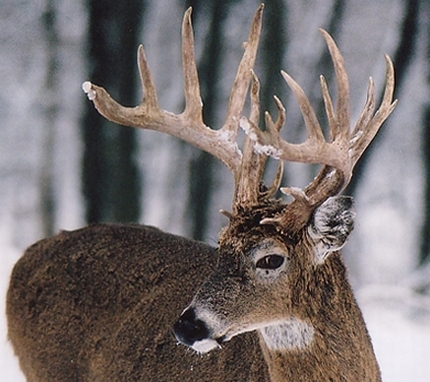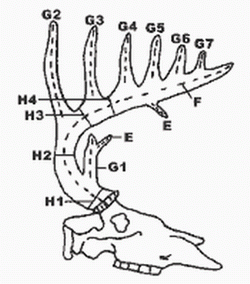Throughout the previous parts of this series on how to score white-tailed deer using the Boone & Crockett method we have gone over scoring terminolgy and have examined all the factors that impact gross and net scores, in addition to classifying typical and nontypical white-tailed deer antlers. By this point, you know that the widest inside spread between beams, beam lengths, circumferences, and point (tine) lengths all add together to give a gross B&C score. We also discussed how deductions are calculated and how this impacts net score.
Now at this point, I’m going to tell you exactly how to take the main beam measurements as well as mass (circumference) measurements. First, make sure you have the proper scoring equipment, then take the the right beam length by measuring from the bottom of the burr to the very tip of the beam (see diagram below). Repeat this process on the left beam. Record these measurements to the nearest eighth and beam measurements are completed.

Now, let’s discuss taking mass measurements. There are always 4 mass measurements taken on each the left and the right antlers. The H1 measurement is the smallest circumference between the burr and the G1. Check the circumference at several locations between the burr and base of the G1 and record the smallest circumference.
The H2 measurement is the smallest circumference between the G1 and G2. The H3 measurement is the smallest circumference between the G2 and G3. The H4 measurement is the smallest circumference between the G3 and G4. If the antlers you are scoring are from a typical 10-point (or more) rack, the measurements are simple to take.

However, if you are scoring an 8-point rack, there is no G4! In this case, the H4 measurement must be taken from half-way between the G3 and the tip of the main. Simply measure the main beam from the center of the G3 to the tip of the beam, divide by 2, and mark the beam this distance from the end. Take your H4 circumference and your mass measurements for that side are completed.
Keep in mind that on a 9-point rack with 4 normal points on one side and 5 normal points on the other, the H4 on one side will be taken between the G3 and G4, but the H4 on the other side will be taken between the G3 and the tip of the beam. With an unmatched (unpaired) point, a sizeable deduction will likely be evident between the right H4 and left H4 (the G4 will be deducted from the net score as well). As I mentioned earlier, symmetry is good and asymmetry is bad when it comes to Boone and Crockett scores and white-tailed deer.




I do not understand how to get 4 mass measurements on each beam of a typical 6 point. One that has brow tines and a G2 and G3. I have killed 2 big cull 6 points and apparently have underscored both, having only taken 2 mass measurements on each beam. Please help me understand how to measure the mass.
Mickey, on a typical 6 point you would measure halfway between the G2 and the tip of the main beam. At that location you take a circumference measurement, except this measurement counts twice if no G3 is present (such as your typical 6). Multiply that measurement by 2 and that gives you the remaining 2 mass measurements (the H3 and H4 measurements being this same measurement).
In the case of the antler with only a brow tine and a main beam, take the circumference halfway between the brow tine and the tip of the main beam and multiply by 3 (for H2, H3 and H4). That was the way I learned from an old official B&C scorer back when B&C scoring wasn’t popular yet.
Mickey, it sounds like you have a buck with 4 points on one antler and 2 on the other. If this is the case, then do exactly like Hunter D says in his second paragraph for the antler with only a G1 and G2. The circumference between the G2 and the tip of the beam will be your H2, H3, and H4 measurements.
For the antler with 4 points, you would score it like a typical 8 point deer. Take your H1, H2, and H3 measurement as normal, but for your H4 measurement measure halfway along the beam between the G3 and the tip and take your H4 measurement there. Every antler gets 4 circumference measurements.
I shot a buck with a thick common base that when measured has a mass of 8 inches. The other mass measurements are around 4-5 inches. Can I still use the measurement from the common base? And if so how do you tell a common base from a low fork in the antler?
If my buck has 2 main beams. Do I measure mass on the second beam?
Jacob, you only measure mass (circumference) on matched beams. The other/extra beam is considered abnormal, so it is added as to the column of abnormal points.
How do I score my deer, that would be a typical 10, but is missing one of his brow tines? How do measurements and deductions work with a missing G1? Thanks!
AJ, the deer would get a 0 for the missing G1. If scored typical then, not only do you end up getting a 0 for the missing G1, but you also end up deducting the length of the other G1 for the net score. This is why most hunters prefer to talk about the gross score of a buck, since it includes every inch of measurable antler.
If G1 is broken off and less than an inch do you use the measurement between base and G1 just as if it wasn’t broken and between G1 and G2 for your H2 measurement?